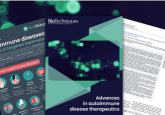The hygiene hypothesis: how gut microbes arm us against autoimmunity

According to the hygiene hypothesis, the increasing incidence of autoimmune diseases in Western countries may be explained by changes in early microbial exposure. Recent studies point to the importance of a healthy gut microbiota in protecting against autoimmunity.

In recent decades, industrialized countries have witnessed a substantial increase in the frequency of allergic and autoimmune diseases, even as the incidence of infectious diseases has declined. This observation gave rise to the hygiene hypothesis, which proposes that a reduction in the frequency of infections contributes directly to the increase in the frequency of autoimmune and allergic diseases. This notion is supported by a wealth of data in humans and animal models for autoimmune diseases such as multiple sclerosis, type 1 diabetes, and inflammatory bowel disease (IBD).
Recent studies suggest that pathogens and gut bacteria can help protect against autoimmunity (1). A number of studies in animal models have highlighted an important role for pathogens, demonstrating that autoimmune disease is prevented by infection with bacteria, viruses, and parasites. Moreover, with the recent emergence of metagenomics, it has become possible to determine the composition of commensal gut-resident bacteria, which has led to studies on the role of the gut microbiota in the hygiene hypothesis.
The Influence of Worms
A study published last April in Science illustrates how pathogens and gut microbes may interact to protect against autoimmunity (2). The findings revealed that infection with parasitic worms called helminths protects Nod2-deficient mice, which are genetically susceptible to a type of IBD called Crohn’s disease, from intestinal abnormalities by promoting the expansion of protective bacterial communities that inhibit proinflammatory bacterial taxa. Notably, the researchers found that individuals from helminth-endemic regions harbor a similar protective microbiota.
According to the authors, these results support a model of the hygiene hypothesis in which certain individuals are genetically susceptible to the consequences of a changing microbial environment. “This study is important because it provides experimental evidence that parasitic helminths can block inflammatory diseases, such as IBD, and also provides an explanation for how that may occur,” said senior study author Ken Cadwell of the New York University School of Medicine. “We’ve known for a while that the absence of parasites due to hygiene correlates with lack of IBD. In our study, we show that the presence of parasites can alter the composition of the microbiome in a way that is beneficial.”
But Cadwell cautions that the findings are not ready for clinical translation. For one, soil-transmitted helminths, found mainly in areas where sanitation and hygiene are poor, can cause a range of health problems, from abdominal pain and diarrhea to physical and cognitive growth retardation. Moreover, many Crohn’s disease patients do not carry NOD2variants and therefore may not respond to helminths, which have failed in clinical trials. “Although people have been exploring the idea of using helminths to treat diseases, or ‘worm therapy,’ it is difficult to do so in a safe and effective way,” Cadwell said. “The main weakness is that ethical concerns prevent us from testing these concepts in human IBD patients.”
Based on the findings, Cadwell and his collaborators are currently pursuing several avenues, such as determining whether it is possible to isolate human gut microbes that promote the beneficial effects of helminth infection. “By answering these questions, we can find pathways that determine whether an individual develops IBD, and we can exploit these pathways for therapy,” Cadwell said.
Antibiotics and Probiotics
A growing body of evidence in animal models suggests that the gut microbiome may be a key factor in influencing predisposition to a variety of autoimmunity and allergic diseases. In a study published in 2015 in the ISME Journal, researchers found that the gut microbiota of diabetic mice harbored more pathobionts and fewer beneficial microbes compared with diabetes-resistant mice [3]. In addition, fecal transplantation of microbes from the diabetic mice into the normally diabetes-resistant mice exacerbated pancreatic inflammation. “This suggested that the microbiota have a causative role in disease progression,” said first author Kirsty Brown of the University of British Columbia Okanagan.
Moreover, lifelong antibiotic exposure accelerated diabetes onset in the non-obese diabetic mice and reduced microbial short-chain fatty acid metabolites, which are known to protect against diabetes. However, probiotic treatment did not delay diabetes in these mice, due to poor gut colonization, highlighting the complexity of the role played by the intestinal microbiota in modulating the onset of autoimmune diabetes.
According to the authors, the findings suggest that caution should be taken to prevent the overuse of antibiotics in infants known to be at risk for type 1 diabetes. Understanding which microbes trigger or protect against the disease could help guide the development of more specific antimicrobials as well as effective probiotics.
“In the context of human health, it is important to highlight that this is a proof-of-concept study showing that microbial communities may play a role in disease progression,” Brown said. “It should be noted that we used a mouse strain that is highly susceptible to diabetes and that mouse models do not fully recapitulate human disease. Furthermore, the concentration and duration of antibiotics used in our study are unlikely to be prescribed in a clinical setting.”
Mapping the Human Microbiota
Intriguingly, the hygiene hypothesis likely explains the uneven geographical distribution of autoimmune diseases in the world. Several studies have demonstrated a global gradient in the incidence of type 1 diabetes, multiple sclerosis, and other autoimmune diseases in association with improved sanitation and decreased incidence of early childhood infections. A microcosm of the global gradient in immune disease incidence occurs at the border between Finland and Russian Karelia, where there is a 2- to 6-fold higher incidence of allergies and a 5- to 6-fold higher incidence of type 1 diabetes and other autoimmune disorders in Finland, despite the similar climate and shared ethnic background of the populations . In nearby Estonia, coinciding with economic development and improvement in living standards, the incidence of type 1 diabetes has been transitioning in recent decades from rates similar to those of Russian Karelia toward those of Finland.
In a study published last June in Cell, researchers set out to characterize host–microbe immune interactions contributing to autoimmunity and allergy by following gut microbiome development from birth until age 3 in 222 infants in Northern Europe [4]. Using strain-level microbial identification, they uncovered substantial differences in the composition, diversity, and stability of the early gut microbiome in Russian, Finnish, and Estonian children.
Compared to Russian infants, Finnish and Estonian infants harbored a greater proportion of Bacteroides species, which produced a structurally and functionally distinct form of lipopolysaccharide compared with the dominating form of Escherichia coli-derived lipopolysaccharide found in the Russian infant microbiome. Strikingly, the protective effect of this molecule depends on its bacterial source. E. coli-derived lipopolysaccharide isolated from the microbiota of individuals living in Karelia exerted a substantial protective effect against autoimmune diabetes in non-obese diabetic mice. By contrast, Bacteroides-derived lipopolysaccharide did not decrease the incidence of the disease in non-obese diabetic mice.
The findings suggest that microbiome-derived lipopolysaccharide could impact long-term immunosuppressive mechanisms in more complex ways than has been previously appreciated. More broadly, the results point to one potential mechanism linking the human gut microbiome to susceptibility to immune diseases; however, the authors noted that the effects of the hygiene hypothesis are most likely mediated through a complex interplay of environmental factors.
According to first author Tommi Vatanen of the Broad Institute of MIT and Harvard, further research is needed to understand how changes in the gut bacteria and the immune system lead to the onset of type 1 diabetes. “We are currently implementing a probiotic trial where we introduce tentatively beneficial bifidobacteria in Finnish neonates to test for any effects in microbial community assembly and immune system development,” he said. “We are also studying the gut microbiome in these and other populations in much more detail to better understand the early assembly of the microbial communities, their development, and interactions with the human immune system.”
Additional evidence in humans suggests that a healthy gut microbiota is key for protecting against not only type 1 diabetes but also multiple sclerosis. Patients with multiple sclerosis and their families report an increased incidence of gastrointestinal symptoms such as constipation and IBD. In a study published last June in Scientific Reports, Ashutosh Mangalam of the University of Iowa and his team showed that patients with multiple sclerosis have a distinct microbial community profile compared to healthy controls (5). Analysis of the fecal microbiota composition revealed that relapsing-remitting multiple sclerosis patients with active disease showed decreased species richness compared to patients in remission and controls. The researchers are currently doing experiments to find out the mechanism by which gut microbiota might protect or predispose to disease.
“I think our study combined with other microbiome studies emphasizes the point that gut microbiota play an important role in our health, and perturbation of the normal microbiota might predispose a genetically susceptible individual to develop disease,” Mangalam said. “Although these are early days, once we can identify what is the normal gut microbiota, then maybe we can use microbiota profiling as a diagnostic tool in the future.”





